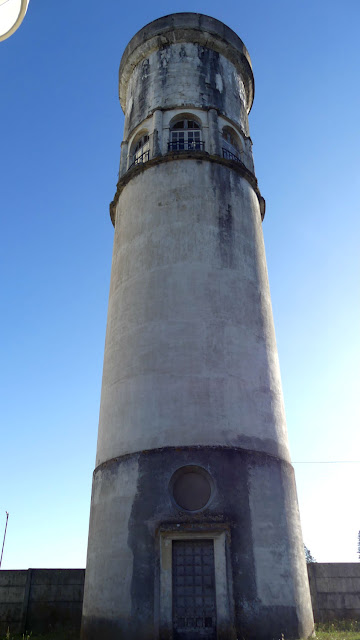We have already twice encountered the hugely influential Swiss architect Le Corbusier (1887-1965) on Invisible Bordeaux, when touring the Cité Frugès prefab housing estate in Pessac and its smaller predecessor in Lège-Cap-Ferret. But the oldest and possibly most surprising of Le Corbusier’s projects in Gironde (and reportedly his first in France) was in fact an unusual lighthouse-like water tower in Podensac, 35 kilometres to the south-east of Bordeaux.
At the time of its construction, in 1917, Le Corbusier still went by the name of Charles-Edouard Jeanneret-Gris. He had been called upon by a friend, the wealthy Girondin entrepreneur François Thévenot, to design the water tower as part of a wider scheme to ensure that Thévenot’s newly-acquired property (the centrepiece of which was to be his residence, Château Chavat) would boast an efficient water management system.
Le Corbusier thus conceived the 25-metre-tall circular steel-reinforced concrete tower, which was delivered by the company which employed him at the time, Société d’Application du Béton Armé (SABA). A spiral staircase wound its way up the inside of the structure to the 80-cubic-metre water tank at its top, but rather than the tower being an opaque vertical cylinder, it also comprised a landing two-thirds of the way up, with eight pairs of tall French windows on all sides offering a panoramic vista over the surrounding area. But was the room solely designed to take in the view? Some sources do indeed call it a “gloriette”, a place to relax and enjoy some downtime, but Le Corbusier referred to it as the “garçonnière”, suggesting it may also have served as a discreet meeting point for the landlord and his “acquaintances”!
Topping off the structure was a terrace, although the original plan to build an additional look-out tower on top never came to fruition.
Around the time of the Second World War, the water tower and the surrounding land became the property of the local council, which split the wider domaine into smaller plots (although the château and its adjoining park remained more or less as-is). The water tower had ceased to operate in 1940, and it was soon to be dwarfed by a far more modern counterpart. The Le Corbusier structure was resolutely ignored and fell into a state of disrepair until, in 1983, two Dutch architects rediscovered the tower and its history.
It was not immediately listed as an historic monument (an application submitted by the local council was rejected in 1986) and, in 1987, its administration was handed over (for a period of 99 years) to “Le Groupe des Cinq”, a collective originally formed by five architects (Laurent Cazalis, Alain Loisier, Bertrand Nivelle, Daniel Sarrazin and Jean de Giacinto) to preserve and revive historic sites, coupling them with cultural events. Throughout the second half of the 1990s, the association oversaw substantial refurbishments conducted on the water tower (notably the roofing, the terrace, and the interior and windows of the garçonnière) and, in November 2005, the Château Chavat park, its water features, greenhouses and water tower were all finally listed as historic monuments.
Ever since then, le Groupe des Cinq has worked on bringing the water tower to life, developing its touristic, pedagogical, cultural and historical appeal. This has translated into its inclusion on local tourist maps, hosting school groups, and the organization of various exhibitions, installations and the like. Memorable shows have included "sound sculptures" by the acoustician Didier Blanchard in partnership with composer Georges Bloch back in 1995, and a lightshow and spoken word performance entitled “Les jardins noctiluques” in 2006.
 |
| The ground-level entrace to the water tower. |
But perhaps that’s the way Podensac wants it to remain. While architecture enthusiasts might flock to Le Corbusier’s Villa Savoye in Poissy, the Cité Radieuse in Marseille and the recently UNESCO-listed Cité Frugès in Pessac, this lowly water tower is not so much as signposted and remains tucked away, off the beaten track, sandwiched between an inhospitable car park and a football pitch: Gironde’s strangest and unlikeliest architectural claim to fame.
 |
| Le Corbusier loses out in the battle of the water towers by some margin. |
> Find it on the Invisible Bordeaux map: Podensac water tower, rue Pierre-Vincent, Podensac
> Ce dossier est également disponible en français !
> Ce dossier est également disponible en français !
> The Podensac water tower has its own, dedicated website:
http://www.chateaudeaulecorbusier.sitew.fr Resources available include plans and archive photographs of the tower being built, see http://www.chateaudeaulecorbusier.sitew.fr/#LES_PLANS_.B
This 3-D simulation, produced by Le Groupe des Cinq, gives an idea of what the water tower is like on the inside:












0 commentaires: